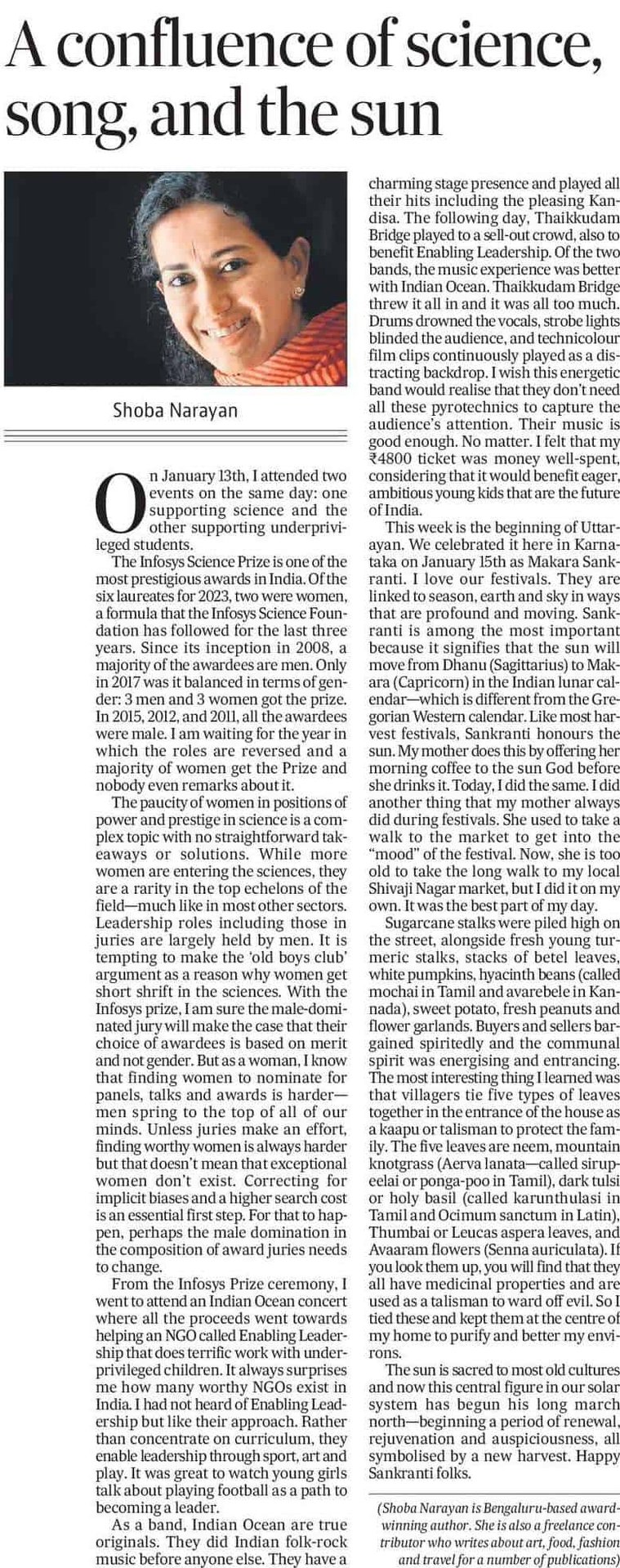On January 13th, I attended two events on the same day: one supporting science and the other supporting underprivileged students.
The Infosys Science Prize is one of the most prestigious awards in India. Of the six laureates for 2023, two were women, a formula that the Infosys Science Foundation has followed for the last three years. Since its inception in 2008, a majority of the awardees are men. Only in 2017 was it balanced in terms of gender: 3 men and 3 women got the prize. In 2015, 2012, and 2011, all the awardees were male. I am waiting for the year in which the roles are reversed and a majority of women get the Prize and nobody even remarks about it.
The paucity of women in positions of power and prestige in science is a complex topic with no straightforward takeaways or solutions. While more women are entering the sciences, they are a rarity in the top echelons of the field—much like in most other sectors. Leadership roles including those in juries are largely held by men. It is tempting to make the ‘old boys club’ argument as a reason why women get short shrift in the sciences. With the Infosys prize, I am sure the male-dominated jury will make the case that their choice of awardees is based on merit and not gender. But as a woman, I know that finding women to nominate for panels, talks and awards is harder—men spring to the top of all of our minds. Unless juries make an effort, finding worthy women is always harder but that doesn’t mean that exceptional women don’t exist. Correcting for implicit biases and a higher search cost is an essential first step. For that to happen, perhaps the male domination in the composition of award juries needs to change.
From the Infosys Prize ceremony, I went to attend an Indian Ocean concert where all the proceeds went towards helping an NGO called Enabling Leadership that does terrific work with underprivileged children. It always surprises me how many worthy NGOs exist in India. I had not heard of Enabling Leadership but like their approach. Rather than concentrate on curriculum, they enable leadership through sport, art and play. It was great to watch young girls talk about playing football as a path to becoming a leader.
As a band, Indian Ocean are true originals. They did Indian folk-rock music before anyone else. They have a charming stage presence and played all their hits including the pleasing Kandisa. The following day, Thaikkudam Bridge played to a sell-out crowd, also to benefit Enabling Leadership. Of the two bands, the music experience was better with Indian Ocean. Thaikkudam Bridge threw it all in and it was all too much. Drums drowned the vocals, strobe lights blinded the audience, and technicolour film clips continuously played as a distracting backdrop. I wish this energetic band would realise that they don’t need all these pyrotechnics to capture the audience’s attention. Their music is good enough. No matter. I felt that my Rs. 4800 ticket was money well-spent, considering that it would benefit eager, ambitious young kids that are the future of India.
This week is the beginning of Uttarayan. We celebrated it here in Karnataka on January 15th as Makara Sankranti. I love our festivals. They are linked to season, earth and sky in ways that are profound and moving. Sankranti is among the most important because it signifies that the sun will move from Dhanu (Sagittarius) to Makara (Capricorn) in the Indian lunar calendar—which is different from the Gregorian Western calendar. Like most harvest festivals, Sankranti honours the sun. My mother does this by offering her morning coffee to the sun God before she drinks it. Today, I did the same. I did another thing that my mother always did during festivals. She used to take a walk to the market to get into the “mood” of the festival. Now, she is too old to take the long walk to my local Shivaji Nagar market, but I did it on my own. It was the best part of my day.
Sugarcane stalks were piled high on the street, alongside fresh young turmeric stalks, stacks of betel leaves, white pumpkins, hyacinth beans (called mochai in Tamil and avarebele in Kannada), sweet potato, fresh peanuts and flower garlands. Buyers and sellers bargained spiritedly and the communal spirit was energising and entrancing. The most interesting thing I learned was that villagers tie five types of leaves together in the entrance of the house as a kaapu or talisman to protect the family. The five leaves are neem, mountain knotgrass (Aerva lanata—called sirupeelai or ponga-poo in Tamil), dark tulsi or holy basil (called karunthulasi in Tamil and Ocimum sanctum in Latin), Thumbai or Leucas aspera leaves, and Avaaram flowers (Senna auriculata). If you look them up, you will find that they all have medicinal properties and are used as a talisman to ward off evil. So I tied these and kept them at the centre of my home to purify and better my environs.
The sun is sacred to most old cultures and now this central figure in our solar system has begun his long march north—beginning a period of renewal, rejuvenation and auspiciousness, all symbolised by a new harvest. Happy Sankranti folks.
Shoba Narayan is Bangalore-based award-winning author. She is also a freelance contributor who writes about art, food, fashion and travel for a number of publications.



-k4lD-U204025897261YmH-250x250%40HT-Web.jpg)




Leave A Comment